Drawing simple shapes#
Note
Note that because we are exposing the Web Canvas API, you can find more tutorials and documentation following this link: https://developer.mozilla.org/en-US/docs/Web/API/Canvas_API
There are some API differences though:
The Canvas widget is directly exposing the CanvasRenderingContext2D API
All the API is written in snake_case instead of camelCase, so for example
canvas.fillStyle = 'red'in JavaScript becomescanvas.fill_style = 'red'in Python
Before we can start drawing, we need to talk about the canvas grid. The origin of this grid is positioned in the top left corner at coordinate (0,0). All elements are placed relative to this origin. So the position of the top left corner of the blue square becomes x pixels from the left and y pixels from the top, at coordinate (x,y).
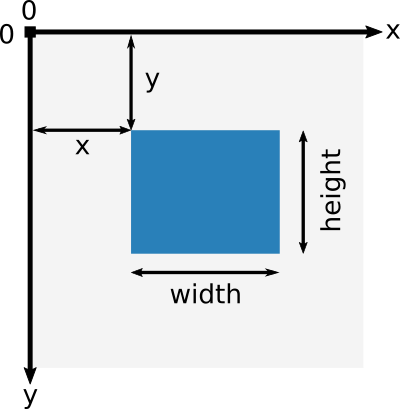
Drawing rectangles#
There are six methods that draw rectangles on the canvas:
fill_rect(x, y, width, height=None):Draws a filled rectangle. If
heightis None, it is set to the same value aswidth.
stroke_rect(x, y, width, height=None):Draws a rectangular outline. If
heightis None, it is set to the same value aswidth.
fill_rects(x, y, width, height=None):Draws filled rectangles. Where
x,y,widthandheightare either integers, lists of integers or NumPy arrays. Ifheightis None, it is set to the same value aswidth.
stroke_rects(x, y, width, height=None):Draws rectangular outlines. Where
x,y,widthandheightare either integers, lists of integers or NumPy arrays. Ifheightis None, it is set to the same value aswidth.
fill_styled_rects(x, y, width, height, color, alpha):Same as
fill_rectsbut with additional(n x 3)colorndarray and(n)alphandarray.
stroke_styled_rects(x, y, width, height, color, alpha):Same as
stroke_rectsbut with additional(n x 3)colorndarray and(n)alphandarray.
You can also clear a certain canvas rectangle area:
clear_rect(x, y, width, height=None):Clears the specified rectangular area, making it fully transparent. If
heightis None, it is set to the same value aswidth.
from ipycanvas import Canvas
canvas = Canvas(width=200, height=200)
canvas.fill_rect(25, 25, 100, 100)
canvas.clear_rect(45, 45, 60, 60)
canvas.stroke_rect(50, 50, 50, 50)
canvas

fill_rects and stroke_rects are blazingly fast ways of drawing up to a million rectangles at once:
import numpy as np
from ipycanvas import Canvas
n_particles = 100_000
x = np.array(np.random.rayleigh(250, n_particles), dtype=np.int32)
y = np.array(np.random.rayleigh(250, n_particles), dtype=np.int32)
size = np.random.randint(1, 3, n_particles)
canvas = Canvas(width=800, height=500)
canvas.fill_style = "green"
canvas.fill_rects(x, y, size)
canvas
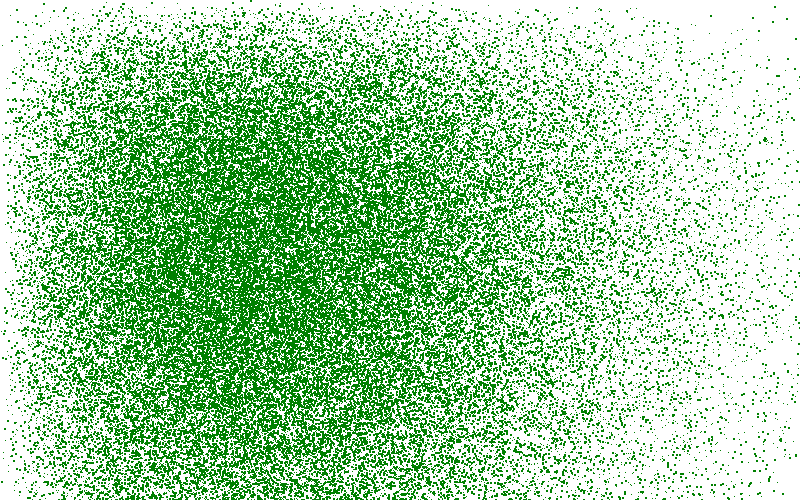
Drawing polygons#
You can draw a polygon by providing a list of points, either a Python list, or a NumPy array. It’s the fastest way to draw a polygon with ipycanvas.
fill_polygon(points):Fill a polygon from a list of points
[(x1, y1), (x2, y2), ..., (xn, yn)].
stroke_polygon(points): Draw polygon outline from a list of points[(x1, y1), (x2, y2), ..., (xn, yn)].fill_polygons(points, points_per_polygon=None):Fill multiple polygons at once.
stroke_polygons(points, points_per_polygon=None):Stroke multiple polygons at once. See Polygons / line-segments for details.
fill_styled_polygons(points, color, alpha, points_per_polygon=None):Fill multiple polygons at once where each polygon can have its own color. See Polygons / line-segments for details.
stroke_styled_polygons(points, color, alpha, points_per_polygon=None):Stroke multiple polygons at once where each polygon can have its own color. See Polygons / line-segments for details.
from ipycanvas import Canvas
canvas = Canvas(width=200, height=200)
canvas.fill_style = "#63934e"
canvas.stroke_style = "#4e6393"
canvas.line_width = 5
canvas.fill_polygon([(20, 20), (180, 20), (100, 150)])
canvas.stroke_polygon([(20, 20), (180, 20), (100, 150)])
canvas

from math import pi
import numpy as np
from ipycanvas import Canvas
def polygon(canvas, x, y, radius, n_points):
angles = (2 * pi / n_points) * np.arange(n_points)
v_x = x + np.cos(angles) * radius
v_y = y + np.sin(angles) * radius
points = np.stack((v_x, v_y), axis=1)
canvas.fill_polygon(points)
background_color = "#89c64f"
polygon_color = "#c6574f"
canvas = Canvas(width=200, height=200)
canvas.fill_style = background_color
canvas.fill_rect(0, 0, canvas.width, canvas.height)
canvas.fill_style = polygon_color
polygon(canvas, 100, 100, 70, 6)
canvas

Drawing arcs and circles#
There are methods that draw arcs/circles on the canvas:
fill_arc(x, y, radius, start_angle, end_angle, anticlockwise=False):Draw a filled arc centered at
(x, y)with a radius ofradius.
stroke_arc(x, y, radius, start_angle, end_angle, anticlockwise=False):Draw an arc outline centered at
(x, y)with a radius ofradius.
fill_arcs(x, y, radius, start_angle, end_angle, anticlockwise=False):Draw filled arcs centered at
(x, y)with a radius ofradius. Wherex,y,radiusand other arguments are NumPy arrays, lists or scalar values.
stroke_arcs(x, y, radius, start_angle, end_angle, anticlockwise=False):Draw an arc outlines centered at
(x, y)with a radius ofradius. Wherex,y,radiusand other arguments are NumPy arrays, lists or scalar values.
fill_styled_arcs( x, y, radius, start_angle, end_angle, color, alpha, anticlockwise=False):Same as
fill_arcsbut with additional(n x 3)colorndarray and(n)alphandarray.
stroke_styled_arcs( x, y, radius, start_angle, end_angle, color, alpha, anticlockwise=False):Same as
stroke_arcsbut with additional(n x 3)colorndarray and(n)alphandarray.
fill_circle(x, y, radius):Draw a filled circle centered at
(x, y)with a radius ofradius.
stroke_circle(x, y, radius):Draw an circle outline centered at
(x, y)with a radius ofradius.
fill_circles(x, y, radius):Draw filled circles centered at
(x, y)with a radius ofradius. Wherex,y,radiusare NumPy arrays, lists or scalar values.
stroke_circles(x, y, radius):Draw a circle outlines centered at
(x, y)with a radius ofradius. Wherex,y,radiusare NumPy arrays, lists or scalar values.
fill_styled_circles( x, y, radius color, alpha):Same as
fill_circlesbut with additional(n x 3)colorndarray and(n)alphandarray.
stroke_styled_circles( x, y, radius, color, alpha):Same as
stroke_circlesbut with additional(n x 3)colorndarray and(n)alphandarray.
from math import pi
from ipycanvas import Canvas
canvas = Canvas(width=200, height=200)
canvas.fill_style = "red"
canvas.stroke_style = "blue"
canvas.fill_arc(60, 60, 50, 0, pi)
canvas.stroke_circle(60, 60, 40)
canvas

Drawing lines#
There are two commands for drawing a straight line from one point to another:
stroke_line(x1, y1, x2, y2):Draw a line from
(x1, y1)to(x2, y2).
stroke_lines(points):Draw a path of consecutive lines from a list of points
[(x1, y1), (x2, y2), ..., (xn, yn)].
stroke_styled_line_segments(points, points_per_line_segment=None):Draw multiple disconnected line-segments at once. See Polygons / line-segments for details.
stroke_styled_line_segments(points, color, alpha, points_per_line_segment=None):Draw multiple disconnected line-segments at once. See Polygons / line-segments for details.
from ipycanvas import Canvas
canvas = Canvas(width=200, height=200)
canvas.stroke_style = "blue"
canvas.stroke_line(0, 0, 150, 150)
canvas.stroke_style = "red"
canvas.stroke_line(200, 0, 0, 200)
canvas.stroke_style = "green"
canvas.stroke_line(150, 150, 0, 200)
canvas

import numpy as np
from ipycanvas import Canvas
canvas = Canvas(width=200, height=200)
n = 50
x = np.linspace(0, 200, n)
y = np.random.randint(200, size=n)
points = np.stack((x, y), axis=1)
canvas.stroke_lines(points)
canvas

Vectorized methods#
Most methods like fill_rect/stroke_rect and fill_circle/stroke_circle have vectorized counterparts: fill_rects/stroke_rects and fill_circles/stroke_circles. It is essential
to use those methods when you want to draw the same shape multiple times with the same style.
For example, it is way faster to run:
from ipycanvas import Canvas
canvas = Canvas(width=300, height=300)
canvas.global_alpha = 0.01
size = [i for i in range(300)]
position = [300 - i for i in range(300)]
canvas.fill_rects(position, position, size)
canvas
instead of running:
from ipycanvas import Canvas
canvas = Canvas(width=300, height=300)
canvas.global_alpha = 0.01
for i in range(300):
size = i
position = 300 - i
canvas.fill_rect(position, position, size)
canvas
Styled vectorized methods#
Ipycanvas provides methods to draw the same shape multiple times but with different colors:
fill_styled_rects/stroke_styled_rectsfill_styled_circles/stroke_styled_circlesfill_styled_arcs/stroke_styled_arcsfill_styled_polygons/stroke_styled_polygonsfill_styled_line_segments/stroke_styled_line_segments
Rects#
import numpy as np
from ipycanvas import Canvas, hold_canvas
canvas = Canvas(width=400, height=300)
n_rects = 300
x = np.random.randint(0, canvas.width, size=(n_rects))
y = np.random.randint(0, canvas.width, size=(n_rects))
width = np.random.randint(10, 40, size=(n_rects))
height = np.random.randint(10, 40, size=(n_rects))
colors_fill = np.random.randint(0, 255, size=(n_rects, 3))
colors_outline = np.random.randint(0, 255, size=(n_rects, 3))
alphas = np.random.random(n_rects)
with hold_canvas():
canvas.fill_styled_rects(x, y, width, height, color=colors_fill, alpha=alphas)
canvas.line_width = 2
canvas.stroke_styled_rects(x, y, width, height, color=colors_outline, alpha=alphas)
canvas
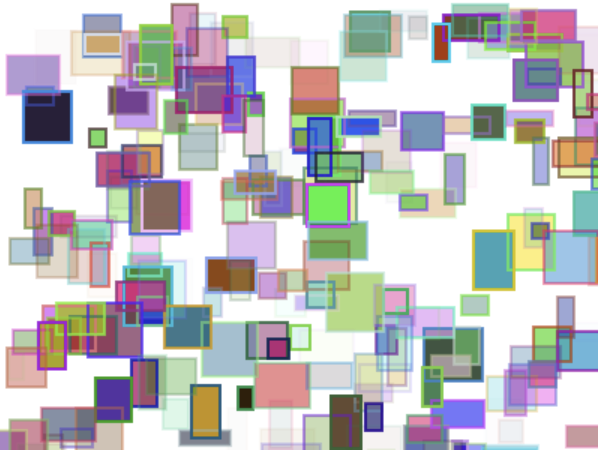
Circles#
import numpy as np
from ipycanvas import Canvas, hold_canvas
canvas = Canvas(width=300, height=300)
n_circles = 100
x = np.random.randint(0, canvas.width, size=(n_circles))
y = np.random.randint(0, canvas.width, size=(n_circles))
r = np.random.randint(10, 20, size=(n_circles))
colors_fill = np.random.randint(0, 255, size=(n_circles, 3))
colors_outline = np.random.randint(0, 255, size=(n_circles, 3))
alphas = np.random.random(n_circles)
with hold_canvas():
canvas.fill_styled_circles(x, y, r, color=colors_fill, alpha=alphas)
canvas.line_width = 2
canvas.stroke_styled_circles(x, y, r, color=colors_outline)
canvas
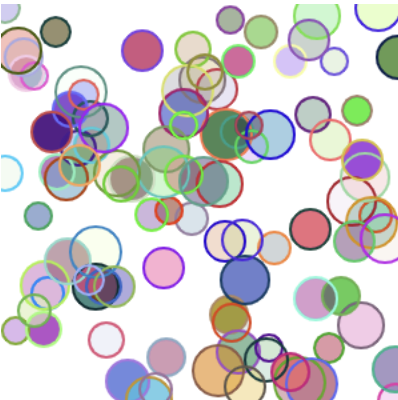
Arcs#
import numpy as np
from ipycanvas import Canvas, hold_canvas
import math
canvas = Canvas(width=300, height=300)
n_circles = 100
x = np.random.randint(0, canvas.width, size=(n_circles))
y = np.random.randint(0, canvas.width, size=(n_circles))
r = np.random.randint(10, 20, size=(n_circles))
start_angle = np.random.randint(0, 360, size=(n_circles))
end_angle = np.random.randint(0, 360, size=(n_circles))
start_angle = 0
end_angle = math.pi
start_angle = np.random.random(n_circles) * math.pi
end_angle = np.random.random(n_circles) * math.pi
alphas = np.random.random(n_circles)
with hold_canvas():
canvas.fill_style = "cyan"
canvas.fill_arcs(x, y, r, start_angle, end_angle)
canvas.line_width = 1
canvas.stroke_style = "black"
canvas.stroke_arcs(x, y, r, start_angle, end_angle)
canvas
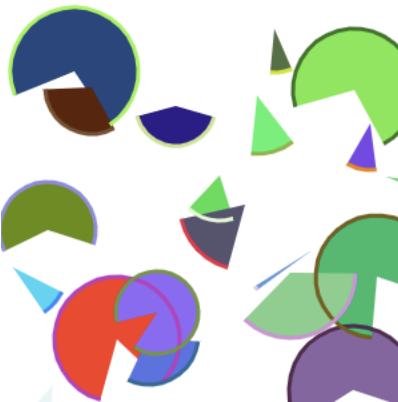
Polygons / line-segments#
Case 1: All polygons / line-segments have the same number of points#
import numpy as np
from ipycanvas import Canvas, hold_canvas
canvas = Canvas(width=300, height=300)
n_polygons = 50
# each polygon has 4 points
n_points_per_polygon = 4
polygons = np.zeros([n_polygons, n_points_per_polygon, 2])
polygons[:, 0, 0] = 0.0
polygons[:, 0, 1] = 0.0
polygons[:, 1, 0] = 1.0
polygons[:, 1, 1] = 0.0
polygons[:, 2, 0] = 1.0
polygons[:, 2, 1] = 1.0
polygons[:, 3, 0] = 0.0
polygons[:, 3, 1] = 1.0
colors_fill = np.random.randint(0, 255, size=(n_polygons, 3))
colors_outline = np.random.randint(0, 255, size=(n_polygons, 3))
# scale each polygon
polygons *= np.linspace(1.0, 200.0, num=n_polygons)[:, None, None]
# translate each polygon
polygons += np.linspace(1.0, 100.0, num=n_polygons)[:, None, None]
points_per_polygon = np.ones([n_polygons]) * n_points_per_polygon
with hold_canvas():
canvas.stroke_styled_polygons(polygons, color=colors_fill)
canvas
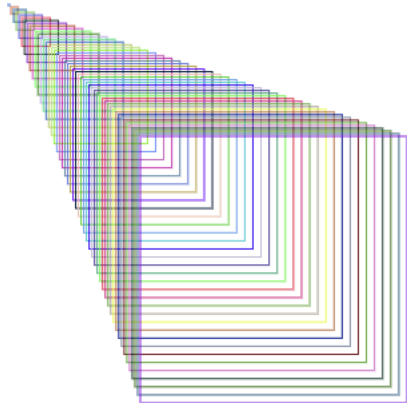
import numpy as np
from ipycanvas import Canvas, hold_canvas
canvas = Canvas(width=300, height=300)
n_line_segments = 20
n_points_per_line_segment = 500
line_segments = np.zeros([n_line_segments, n_points_per_line_segment, 2])
x = np.linspace(0, canvas.width, num=n_points_per_line_segment)[None, :]
line_segments[:, :, 0] = np.linspace(0, canvas.width, num=n_points_per_line_segment)[
None, :
]
line_segments[:, :, 1] = (30.0 * np.sin(x * 0.1))[None, :]
colors_outline = np.random.randint(0, 255, size=(n_polygons, 3))
# translate line segments in y direction
line_segments[:, :, 1] += np.linspace(1.0, canvas.height, num=n_line_segments)[:, None]
with hold_canvas():
canvas.stroke_styled_line_segments(line_segments, color=colors_fill)
canvas
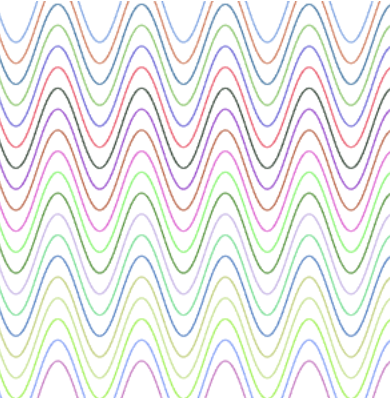
Case 2: Polygons / line-segments can have different number of Points.#
Polygons can be given as a list of ndarrays:
import numpy as np
from ipycanvas import Canvas, hold_canvas
canvas = Canvas(width=400, height=400)
triangle = [(0, 0), (0, 40), (30, 40)] # triangle
rectangle = [(100, 100), (300, 100), (300, 200), (100, 200)] # rectangle
irregular = np.random.randint(0, 400, size=(5, 2)) # irregular with 5 sides
polygons = [triangle, rectangle, irregular]
colors = [(255, 0, 0), (0, 255, 0), (0, 0, 255)]
with hold_canvas():
canvas.fill_styled_polygons(polygons, color=colors)
canvas

Polygons can be given as a flat ndarray:
import numpy as np
from ipycanvas import Canvas, hold_canvas
canvas = Canvas(width=400, height=400)
n_polygons = 20
points_per_polygon = np.random.randint(3, 6, size=n_polygons)
total_points = np.sum(points_per_polygon)
polygons = np.random.randint(0, 400, size=[total_points, 2])
alpha = np.random.random(n_polygons)
colors_fill = np.random.randint(0, 255, size=(n_polygons, 3))
colors_outline = np.random.randint(0, 255, size=(n_polygons, 3))
with hold_canvas():
# the filling
canvas.fill_styled_polygons(
polygons, points_per_polygon=points_per_polygon, color=colors_fill, alpha=alpha
)
# draw outlines ontop where each line has the same style
canvas.stroke_style = "black"
canvas.line_width = 2
canvas.stroke_polygons(polygons, points_per_polygon=points_per_polygon)
canvas
